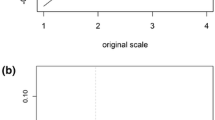Abstract
Applying the computing technology continuum of perspective model into mobile technology, this study investigates tourists’ social attribution to mobile phones while travelling. The tendency to place social attribution to and interact socially with mobile phones in the context of travel is influenced by tourists’ perception of the positive social characteristics of mobile phones (i.e., object attribution) and the intensity of mobile phone use for travel-related purposes at tourism destinations (i.e., circumstance attribution). It was found that tourists’ core selfevaluation did not exert an influence in the process of social attribution to mobile phones. This supports the importance of anthropomorphism in the designing of mobile technology for tourists, in that more intelligent and social phones are potentially more persuasive to influence tourists’ behaviour regardless of their personality.
Access this chapter
Tax calculation will be finalised at checkout
Purchases are for personal use only
Preview
Unable to display preview. Download preview PDF.
Similar content being viewed by others
References
Apple, Inc. (n.d.). Siri: Your Wish is its Command. Retrieved January 3, 2012, from http://www.apple.com/iphone/features/siri.html
Bagozzi, R. P. & Yi, T. (1988). On the Evaluation of Structural Equation Models. Journal of the Academy of Marketing Science 16(1): 74-94.
Chin, W. (1998). The partial least squares approach to structural equation modeling. In Marcoulides. G. A. (ed.), Modern Methods for Business Research (pp. 295-336). New Jersey: Laurence Erlbaum Associates.
Dillon, W.R. & Goldstein, M. (1984). Multivariate Analysis, Methods and Applications. New York: John Wiley & Sons.
Edwards, S. J., Blythe, P. T., Scott, S. & Weihong-Guo, A. (2006). Tourist information delivered through mobile devices: Findings from the image project. Information Technology & Tourism 8: 31-46.
Eysenck, H. J. & Eysenck, S. B. G. (1968). Manual for the Eysenck Personality Inventory. San Diego, CA: Educational and Industrial Testing Service.
Fogg, B.J. (1998). Persuasive computers: Perspectives and research directions. Proceedings of the SIGCHI conference on Human Factors in Computing Systems. New York: ACM Press.
Gretzel, U. (2011). Intelligent systems in tourism: A social science perspective. Annals of Tourism Research 38 (3): 757-779.
Guthrie, S. E. (1993). Faces in the Clouds: A New Theory of Religion. New York: Oxford University Press.
Hall, B. & Henningsen, D. D. (2008). Social facilitation and human–computer interaction. Computers in Human Behavior 24 (6): 2965-2971.
Hu, L., & Bentler, P.M. (1999). Cutoff Criteria for Fit Indexes in Covariance Structure Analysis: Conventional Criteria versus New Alternatives. Structural Equation Modeling 6: 1–55.
Johnson, R. D. (2001). Tool or Social Actor: Factors Contributing to Differential Social Attributions toward Computing Technology. College Park: University of Maryland.
Johnson, R. D., Marakas, G. M. & Palmer, J. W. (2006). Differential social attributions toward computing technology: An empirical examination. International Journal of Human-Computer Studies 64: 446-460.
Johnson, R. D., Marakas, G. M., & Palmer, J. W. (2008). Beliefs about the social roles and capabilities of computing technology: Development of the computing technology continuum of perspective. Behaviour & Information Technology, 27 (2): 169-181.
Kabassi, K. (2010). Personalizing recommendations for tourists. Telematics and Informatics 27 (1): 51-66.
Lee, E.-U. (2010). The more humanlike, the better? How speech type and users’ cognitive style affect social responses to computers. Computers in Human Behavior 26: 665-672.
Levenson, H. (1973). Multidimensional locus of control in psychiatric patients. Journal of Consulting and Clinical Psychology, 41(3): 397-404.
Marakas, G. M., Johnson, R.D., & Palmer, J. W. (2000). A theoretical model of differential social attributions toward computing technology: When metaphor become the model. International Journal of Human-Computer Studies 52: 719-750.
Martin, D., Alzua, A., & Lamsfus, C. (2011). A contextual geofencing mobile tourism service, In R. Law, M. Fuchs, F. Ricci (Eds.), Information and communication technologies in tourism 2011 (Pp. 191-202), Vienna: Springer Verlag.
Muthén, L. K., & Muthén, B. O. (1998-2011). Mplus User’s Guide. Sixth Edition. Los Angeles, CA: Muthén & Muthén.
Nass, C. & Moon, Y. (2000). Machines and mindlessness: Social responses to computers. Journal of Social Issues, 56(1), 81-103.
Nass, C., Moon, Y., Fogg, B. J., Reeves, B. & Dryer, C. (1995). Can computer personalities be human personalities? International Journal of Human–Computer Studies, 43, 223–239.
Nass, C, Steuer, J., & Tauber, E.R. (1994). Computers are social actors. In the proceedings of the SIGCHI conference on Human Factors in Computing Systems: Celebrating interdependence (pp. 72–78), Boston: Massachusetts.
Rasinger, J., Fuchs, M., & Höpken, W. (2007). Information search with mobile tourist guides: A survey of usage intention. Information Technology & Tourism 9(3-4): 177-194.
Reeves, B. & Nass, C. (1996). The Media Equation: How People Treat Computers, Television, and New Media Like Real People and Places. Stanford, CA: Cambridge University Press.
Schmeil, A. & Broll, W. (2007). An Anthropomorphic AR-based Personal Information Manager and Guide. Proceedings of HCI International 2007, July 22-27, Beijing, PR China.
Sproull, L., Subramani, M., Kiesler, S., & Walker, J. H. (1996). When the interface is a face. Human–Computer Interaction, 11: 97–124.
Sundar, S.S. (2004). Loyalty to computer terminals: Is it anthropomorphism or consistency? Behaviour & Information Technology 23(2):107-118.
Turkle, S. (1984). The Second Self. New York: Simon and Schuster. Tussyadiah, Iis P. and Florian J. Zach (2012). The role of geo-based technology in place experiences. Annals of Tourism Research 39 (2): 780-800.
Wang, D., Park, S. & Fesenmaier, D. R. (2011). The role of smartphones in mediating the touristic experience. Journal of Travel Research 51(4): 371-387.
Author information
Authors and Affiliations
Corresponding author
Editor information
Editors and Affiliations
Rights and permissions
Copyright information
© 2013 Springer-Verlag Berlin Heidelberg
About this paper
Cite this paper
Tussyadiah, I. (2013). When Cell Phones Become Travel Buddies: Social Attribution to Mobile Phones in Travel. In: Cantoni, L., Xiang, Z. (eds) Information and Communication Technologies in Tourism 2013. Springer, Berlin, Heidelberg. https://doi.org/10.1007/978-3-642-36309-2_8
Download citation
DOI: https://doi.org/10.1007/978-3-642-36309-2_8
Published:
Publisher Name: Springer, Berlin, Heidelberg
Print ISBN: 978-3-642-36308-5
Online ISBN: 978-3-642-36309-2
eBook Packages: Business and EconomicsBusiness and Management (R0)




